Common menu bar links
Breadcrumb Trail
ARCHIVED - RPP 2006-2007
Immigration and Refugee Board of Canada
 This page has been archived.
This page has been archived.
Archived Content
Information identified as archived on the Web is for reference, research or recordkeeping purposes. It has not been altered or updated after the date of archiving. Web pages that are archived on the Web are not subject to the Government of Canada Web Standards. As per the Communications Policy of the Government of Canada, you can request alternate formats on the "Contact Us" page.
Section 2: Detailed Analysis of Program Activities
As noted in Section 1, the IRB has developed an Integrated Business Plan for 2006-2007. A key part of this plan is the identification of the areas of activities (plans) that are common to the four program activities and that contribute to achieving the strategic priorities set out for the next fiscal year. The plans and expected results associated with these common elements are primarily aimed at achieving the IRB's first two strategic priorities, and are presented in the table below.
Common Elements:
Plans and Expected Results for 2006-2007
| Strategic Outcome: Provide Canadians with well-reasoned, timely decisions on immigration and refugee matters efficiently, fairly and in accordance with the law. | |
| STRATEGIC PRIORITY Integrate common procedural, administrative and adjudicative activities in all Divisions to further promote quality, consistency and efficiency measures |
|
| Plans | Expected Results |
| Policy Instruments and Procedures | |
| Develop policies and procedures on dealing with Vulnerable Persons |
|
| Develop a standardized approach to how the IRB deals with cases involving non-disclosure of information (S.86 cases) |
|
| Elaboration of IRB detention/security framework and implementation of selected elements across the Divisions |
|
| Initiate the development of a common/shared policy on the use of videoconferencing |
|
| Performance Measures | |
| Initiate a standardized approach to present IRB performance indicators, including meaningful cross-divisional indicators, both quantitative and qualitative |
|
| Adjudicative Culture | |
| Develop and implement IRB common guidelines and procedures in relation to counsel conduct |
|
| STRATEGIC PRIORITY Continue to build an organizational culture that supports its people, and is flexible and innovative |
|
| Plans | Expected Results |
| Continue to implement a competency-based HR management strategy across the IRB, including developing competency profiles for functional groups and tools to support their use |
|
| Implement policy on redeployment between the RPD and IAD allowing increased mobility between Divisions |
|
| Cross-training between Divisions and joint training and professional development in place where appropriate |
|
| Provide strategic communications advice and information that reflect changes to procedural, administrative and adjudicative activities |
|
| International | |
| Within the International Program, Divisions and Operations to define respective international priorities |
|
| Coordinate international conference participation |
|
| Linkage with Government Agenda | ||
| Responsiveness | Innovation | Accountability |
The IRB Integrated Business Plan also identifies the elements, tribunal values, operations, and corporate management and services that are distinct to each program activity and that will contribute to realizing our strategic priorities for 2006-2007. These are highlighted in the following detailed analysis.
Refugee Protection Program Activity
The Refugee Protection Division delivers the IRB's refugee protection program activity, and continues to play a pivotal role in enabling the Board to achieve its strategic priorities. A major share of IRB resources are committed to this program activity, which is focused on rendering quality decisions in a consistent, timely manner on refugee protection claims made in Canada.
| Financial Resources ($ millions) | ||
| 2006-2007 | 2007-2008 | 2008-2009 |
| 86.4 | 85.3 | 85.3 |
| Human Resources (Full-time Equivalents) | ||
| 2006-2007 | 2007-2008 | 2008-2009 |
| 825 | 815 | 815 |
The difference in the financial resources and FTE figures for 2006-2007 and 2007-2008 is due mainly to the end of the temporary funding of $2.0 million relating to administrative measures in support of refugee reform within the Refugee Protection program activity.
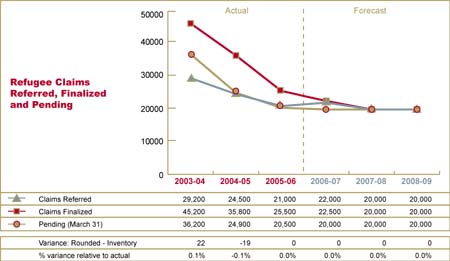
(Click on image to enlarge)
2006-2007 Outlook
For fiscal year 2006-2007, the Refugee Protection Division expects that it will receive approximately 22,000 new claims, 5 percent more than in fiscal year 2005-2006.
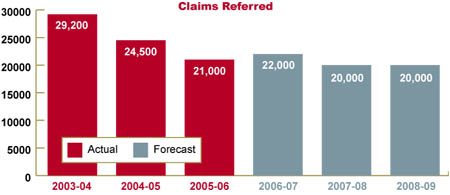
In 2006-2007, the Refugee Protection Division expects to finalize 22,500 cases, 12 percent less than in fiscal year 2005-2006. A continued downward trend of finalizations is anticipated, attributable to a reduced flexibility to schedule hearings and a continued focus on addressing a higher proportion of older, complex and time-consuming cases due to success in finalizing relatively simple, straightforward cases from the inventory.
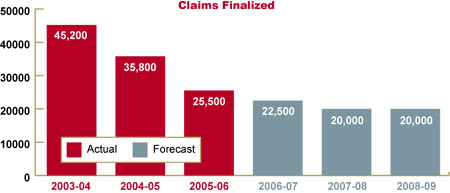
Based on 22,500 claim finalizations, the average cost per claim is expected to be $3,500 for 2006-2007. Unit costs per claim range from $1,300 for an expedited case to $4,400 for complex cases. The projected overall average cost per claim of $3,500 is higher than the 2004-2005 actual average cost of $2,500 per claim. In 2004-2005, there were 35,800 claims finalized. The increase in cost per claim is mainly attributable to increases in salaries and funding for reforms to the refugee determination system, changes in the case mix as a larger share of complex cases are being projected for finalization thus requiring longer hearings, a higher share of fixed costs per unit caused by a drop in volume as well as transition costs associated with reductions in business volumes and required staffing levels.
The cost per claim includes the decision-making costs and costs of related activities such as case preparation, research, scheduling of hearings, legal services, foreign-language interpretation, technological support, translation services, as well as administrative support but it excludes extraordinary items such as the ICMS project development costs. It also includes a share of the costs from the corporate management and services program activity, which is allocated to the three decision-making program activities, based on expenditure trends.
Due to past success in reducing the inventory of claims pending (waiting for a decision), increased resources and improvements in case management processes, the Division is positioned to reduce its inventory to approximately 20,000 claims pending by the end of the 2006-2007 fiscal year, if appointments and re-appointments of decision-makers are made in a timely way.
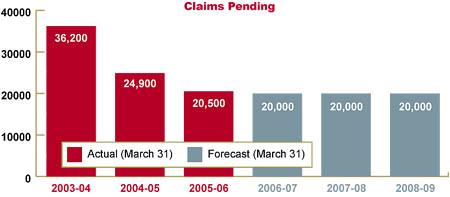
The average processing time continues to drop, and the Division anticipates achieving an 11-month average processing time for the next fiscal year. This is contingent on receiving and maintaining the required level of decision-makers. The Division continues its efforts to seek efficiencies in case processing activities, with a view to decreasing the average processing time.
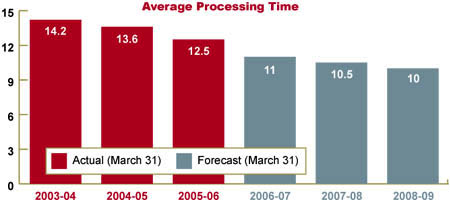
Key Plans and Expected Results
To achieve its forecasts for fiscal year 2006-2007, and in line with the strategic priorities set out for the organization, the refugee protection program activity will undertake the planned activities with the expected results outlined in the following table.
Program Activity: Refugee Protection
Plans and Expected Results for 2006-2007
| Strategic Outcome: Provide Canadians with well-reasoned, timely decisions on immigration and refugee matters efficiently, fairly and in accordance with the law. | |
| STRATEGIC PRIORITY Integrate common procedural, administrative and adjudicative activities in all Divisions to further promote quality, consistency and efficiency measures |
|
| Plans | Expected Results |
| Distinct Elements and Tribunal Values | |
| Further monitoring of RPD Action Plan in order to ensure implementation |
|
| Pursue measures to further streamline RPD processes |
|
| Further reduce pending inventory, processing times and cost by claim by monitoring and expanding Fast Track Initiative, reducing adjournments and postponements, and through more sophisticated streamlining |
|
| Continue to implement and monitor the strategic approach to quality decision-making through quality issue sessions, discussion groups, additional National Documentation Packages, Jurisprudential Guides and Persuasive Decisions, as needed, and Guidelines for Vulnerable Persons |
|
| Facilitate the process of making appointments and re-appointments in a timely way |
|
| Training developed and delivered on various topics including state protection, delivery of reasons, exclusion and Vulnerable Persons Guidelines |
|
| Review and deliver new member training, and deliver focus training for experienced members in all areas identified by RPD |
|
| STRATEGIC PRIORITY Improve case management processes through the successful implementation of ICMS |
|
| Plans | Expected Results |
| ICMS Operations | |
| Development and implementation of Release 4 |
|
| Delivery of required training and simulation exercise |
|
| Post-implementation evaluation focusing on "lessons learned" carried out |
|
| Linkage with Government Agenda | ||
| Responsiveness | Innovation | Accountability |
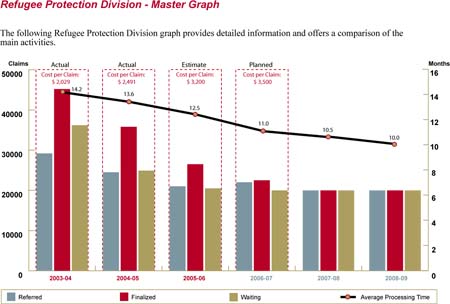
(Click on image to enlarge)
Admissibility Hearings and Detention Reviews Program Activity
The Immigration Division delivers the IRB's admissibility hearing and detention review program activity. Admissibility hearings are held for foreign nationals or permanent residents who are alleged to be inadmissible to Canada pursuant to the provisions of IRPA. Detention reviews are held concerning permanent residents and foreign nationals who are detained under IRPA authority, and must be conducted within specific timeframes set out in IRPA. Decision-makers must balance the rights of individuals to liberty with the security interests of Canadians and persons in Canada. The number of admissibility hearings and detention reviews conducted by the IRB depends on the number of cases referred to it by CBSA and CIC.
| Financial Resources ($ millions) | ||
| 2006-2007 | 2007-2008 | 2008-2009 |
| 15.2 | 15.5 | 15.5 |
| Human Resources (Full-time Equivalents) | ||
| 2006-2007 | 2007-2008 | 2008-2009 |
| 90 | 90 | 90 |
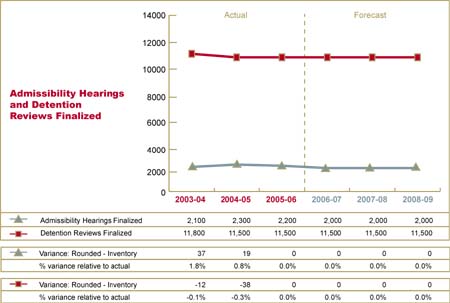
(Click on image to enlarge)
2006-2007 Outlook
The Immigration Division anticipates that the volume of admissibility hearings will remain stable, and expects that 2,000 admissibility hearings will be finalized in 2006-2007. The number of cases being referred to the Division has declined since IRPA was implemented. However, the proportion of complex cases involving war crimes, organized crime, terrorism, transnational crime and foreign criminality has increased.
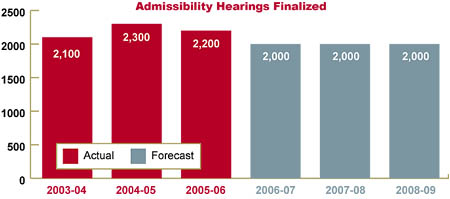
The number of detention reviews conducted by the Immigration Division has also remained stable. The Division anticipates that it will finalize approximately 11,500 detention reviews in 2006-2007. An important factor in detention reviews, criminality is an element that is present in a high proportion of cases, particularly those that involve long-term detention.
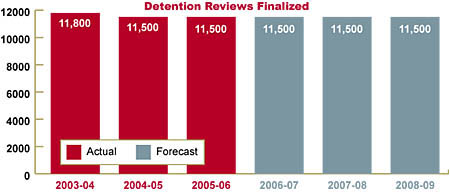
Based on 2,000 admissibility hearings and 11,500 detention reviews, the average cost per admissibility hearing and detention review is expected to be $1,100 and $800, respectively for 2006-2007. These average costs are slightly higher than the 2004-2005 actual average costs, due mainly to increases in salaries and a higher share of fixed costs per unit caused by a slight drop in the projected
The costs per admissibility hearing and detention review include decision-making costs and costs of related activities such as case preparation, scheduling of hearings, legal services, foreign-language interpretation, technological support, translation services, transcribing services, as well as administrative support but it excludes extraordinary items such as the ICMS project development costs. It also includes a share of the costs from the Corporate Management and Services program activity, which is allocated to the three decision-making program activities, based on expenditure trends.
Key Plans and Expected Results
To achieve its forecasts for fiscal year 2006-2007, and in line with the strategic priorities set out for the organization, the admissibility hearings and detention reviews program activity will undertake the planned activities with the expected results outlined in the following table.
Program Activity: Admissibility Hearings
and Detention Reviews
Plans and Expected Results for 2006-2007
| Strategic Outcome: Provide Canadians with well-reasoned, timely decisions on immigration and refugee matters efficiently, fairly and in accordance with the law. | |
| STRATEGIC PRIORITY Integrate common procedural, administrative and adjudicative activities in all Divisions to further promote quality, consistency and efficiency measures |
|
| Plans | Expected Results |
| Distinct Elements and Tribunal Values | |
| Develop harmonized and informal processes to help meet the legislative timeframes and operational requirements to achieve finalization of all cases referred by CBSA and CIC |
|
| Building on the best business practices of IRB, the Immigration Division will introduce and implement innovative approaches to its processes |
|
| Further develop, maintain and promote tools that will support quality, consistency and efficiency in decision-making in the areas of ethics, communications, quality control, and service delivery |
|
| Continue to monitor retirements in order to identify staffing requirements |
|
| Deliver focused and quality training on an ongoing basis in order to meet ID members' specific training needs and address emerging issues (including terrorism, organized crime, etc.) |
|
| Continue to implement learning culture and develop training tools |
|
| Linkage with Government Agenda | ||
| Responsiveness | Innovation | Accountability |
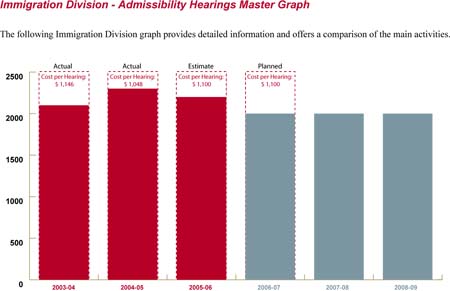
(Click on image to enlarge)
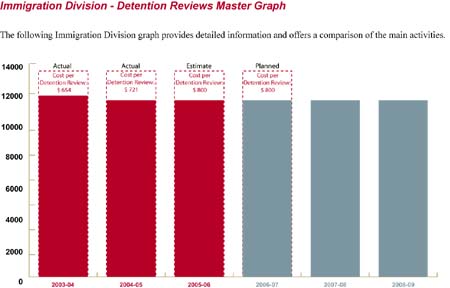
(Click on image to enlarge)
Immigration Appeal Program Activity
The Immigration Appeal Division delivers the IRB's immigration appeal program activity. It hears immigration appeals from Canadian citizens and permanent residents whose applications to sponsor close family members to Canada have been refused. Other key functions include hearing appeals from permanent residents, foreign nationals with a permanent resident visa, and protected persons who have been ordered removed from Canada, as well as from permanent residents outside of Canada who have not fulfilled their residency obligation.
| Financial Resources ($ millions) | ||
| 2006-2007 | 2007-2008 | 2008-2009 |
| 15.2 | 12.9 | 12.9 |
| Human Resources (Full-time Equivalents) | ||
| 2006-2007 | 2007-2008 | 2008-2009 |
| 135 | 120 | 120 |
The difference in the financial resources and FTE figures for 2006-2007 and 2007-2008 is due mainly to the end of the temporary funding of $1.9 million to address short-term pressures to reduce the inventory of sponsored family-class applications in the Immigration Appeal program activity.

(Click on image to enlarge)
2006-2007 Outlook
The Immigration Appeal Division expects the high level of new appeals to continue. In fiscal year 2006-2007, the Division anticipates 6,500 appeals will be filed, which is a volume consistent with the number of appeals received over the last two years.
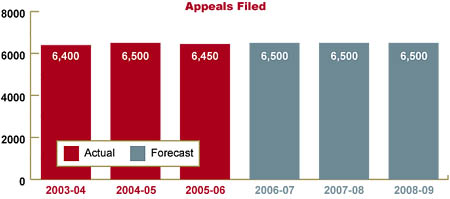
Approximately 6,500 appeals are expected to be finalized, representing an increase of 18 percent over the previous fiscal year. However, the level of finalizations is contingent on the level of resources, as well as on the effective implementation of major changes in the way that appeals are processed. Some of these changes require cooperation or additional resources from CBSA and CIC. The organization will continue to pursue effective internal communications and promote public service values and ethics.
In 2006-2007, the IAD will work on a fundamental transformation of the way it conducts its work through the IAD Innovation initiative, which was launched in September 2005. Also, the complement of IAD members and staff is expected to increase in the next fiscal year as a means of increasing the capacity of the Division.
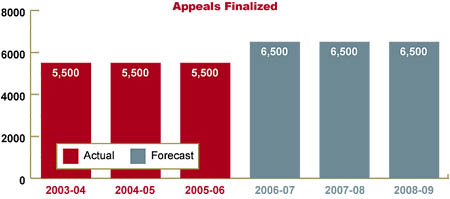
Based on 6,500 appeal finalizations, the average cost per appeal is expected to be $2,100 for 2006-2007. The average cost per appeal is slightly higher than the 2004-2005 actual average cost per appeal due mainly to increases in salaries.
The cost per appeal includes the decision-making costs and costs of related activities such as case preparation, scheduling of hearings, legal services, technological support, translation services, as well as administrative support but it excludes extraordinary items such as the ICMS project development costs. It also includes a share of the costs from the Corporate Management and Services program activity, which is allocated to the three decision-making program activities, based on expenditure trends.
Based on the Division's consistently high productivity and the expected increase in capacity in 2006-2007, the Division will be in a strong position to match the expected intake, preventing a further increase in pending inventory.
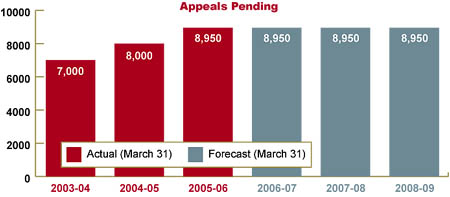
Despite sustained high productivity through case management innovations, the average processing time is expected to be 10 months for fiscal year 2006-2007. Reducing the average processing time is contingent on maintaining an adequate level of resources and effective implementation of the major changes in the IAD Innovative initiative.
Key Plans and Expected Results
To achieve its forecasts for fiscal year 2006-2007, and in line with the strategic priorities set out for the organization, the immigration appeal program activity will undertake the planned activities with the expected results outlined in the following table.
Program Activity: Immigration Appeal
Plans and Expected Results for 2006-2007
| Strategic Outcome: Provide Canadians with well-reasoned, timely decisions on immigration and refugee matters efficiently, fairly and in accordance with the law. | |
| STRATEGIC PRIORITY Integrate common procedural, administrative and adjudicative activities in all Divisions to further promote quality, consistency and efficiency measures |
|
| Plans | Expected Results |
| Distinct Elements and Tribunal Values | |
| Review Alternative Dispute Resolution (ADR) practices and procedures, and case selection |
|
| Expand and improve early review process |
|
| Facilitate the process of making appointments and re-appointments in a timely way |
|
| Develop innovative approach to obtain more information from both parties earlier, to support earlier screening, streaming and resolution |
|
| Members take more proactive control of the hearing process – more limits on issues, questioning, evidence, submissions (relevance), more interventions by members |
|
| Analyze nature and scope of adjournments and postponements; and develop action plans to reduce the postponement/adjournment rate |
|
| Review ADR in-house training |
|
| Develop customized training plan for new members (if necessary) |
|
| Linkage with Government Agenda | ||
| Responsiveness | Innovation | Accountability |
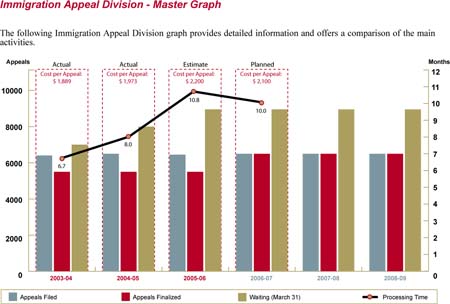
(Click on image to enlarge)
Corporate Management and Services Program Activity
The corporate management and services program activity provides important infrastructure to support the IRB's decision-making function as an effective, accountable, efficient operation, and to implement government-wide management and improvement initiatives. The IRB continues to make significant commitments to provide decision-makers with up-to-date and innovative management practices, infrastructure tools and resources in order to sustain a high volume of quality decisions at the Board.
The corporate management and services program activity at the IRB encompasses executive offices, planning, finance, administration, communications, human resources, legal services, information management and information technology.
As noted in Section 1, the planned spending and FTEs for corporate management and services are proportionally allocated to the three decision-making program activities.
Key Plans and Expected Results
In line with the strategic priorities set out for the organization, the corporate management and services program activity will undertake the planned activities with the expected results outlined in the following table.
Program Activity: Corporate Management and Services
Plans and Expected Results for 2006-2007
| Strategic Outcome: Provide Canadians with well-reasoned, timely decisions on immigration and refugee matters efficiently, fairly and in accordance with the law. | |
| STRATEGIC PRIORITY Improve case management processes through the successful implementation of ICMS |
|
| Plans | Expected Results |
| Corporate Management and Services | |
| Provide on-going maintenance of ICMS applications once implemented |
|
| Transition ICMS IT resources, tools, procedures and infrastructure to the IS Directorate |
|
| Implement a change management strategy with respect to the ICMS project that includes comprehensive communications and training plans |
|
| STRATEGIC PRIORITY Implement a horizontal and fully integrated management plan that reflects the IRB's reality |
|
| Plans | Expected Results |
| Corporate Planning and Accountability | |
| Update the Risk Management Plan to reflect strategic priorities, the Government Management Agenda and implement the Legal Risk Management System |
|
| Provide effective financial planning and budgeting using ABB, A-Base Reviews and other tools to support resourcing process within IRB |
|
| Develop an HR Planning tool to facilitate the integration of HR Planning in business planning |
|
| Audit and Evaluation | |
| Update the 3-year action plan to bring the IRB into compliance with the new internal audit policy |
|
| People Management | |
| Implement identified priorities of the People Management Strategy, including the implementation of an integrated learning and professional development program for all IRB personnel |
|
| Implement HR Modernization measures and objectives including those related to compliance with the new PSLRA and PSMA |
|
| Receive and analyze PSES results, and develop an action plan to address the results |
|
| Revise the GIC recruitment process to ensure further alignment with the Member Competency Profile, including revisions to the screening test and interview guide for GIC recruitment |
|
| Examine the possibility of the development of a unique classification standard for the IRB |
|
| Financial Management | |
| Implement formal management monitoring function |
|
| Security | |
| Implement a comprehensive security program that includes a Business Continuity Plan updated annually and the implementation of the Management Information Technology Security (MITS) Action Plan |
|
| Procurement and Asset Management | |
| Implement a comprehensive procurement and asset management program |
|
| Development of appropriate contracting regimes and controls on interpreter file |
|
| Information Management | |
| Implement the relevant elements of the Information Management (IM) action plan following the IM Capacity exercise |
|
| Using Infonet, provide all employees with authoritative, comprehensive and well-structured information in support of their respective operational goals and obligations |
|
| Information Systems | |
| Support IRB's activities with the appropriate infrastructure, desktop and network environment |
|
| Support all Systems users (external and internal) effectively and in accordance with service standards |
|
| Linkage with Government Agenda | ||
| Responsiveness | Innovation | Accountability |
